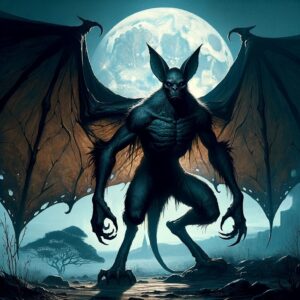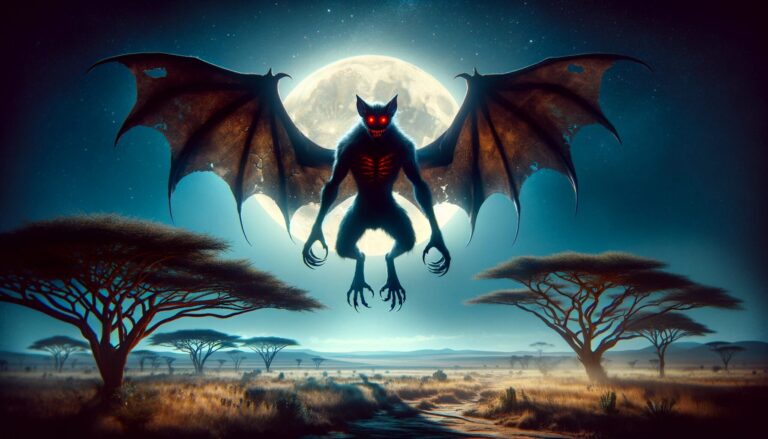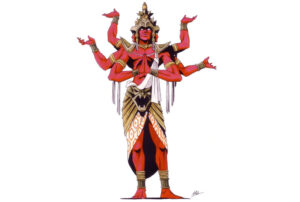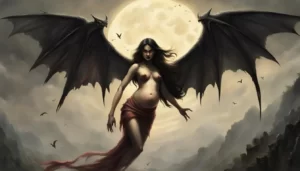Table of Contents
In the mystical and enigmatic realms of African folklore, there exists a creature that haunts the darkest corners of the night, striking fear into the hearts of those who dare to speak its name. Furthermore, this malevolent entity is known as the Popobawa, a shapeshifting terror that originates from the mystical island of Zanzibar, situated off the coast of Tanzania. The Popobawa is a creature that transcends ordinary understanding, uniquely embodying a rich tapestry of legends, fears, and enigmatic tales.
Origins and Cultural Significance
The folklore of Zanzibar, an island with a long and rich history of Swahili culture and traditions, deeply roots the origins of the Popobawa. Furthermore, the name “Popobawa” itself translates roughly to “winged bat” in Swahili. Its origins, dating back to the 1960s, can be traced to a complex amalgamation of African, Arabic, and even colonial influences, rendering it a fascinating subject of study.
The Popobawa is most closely associated with Zanzibar’s Pemba Island, which has the dubious honor of being the creature’s supposed epicenter. Although the creature primarily known on Pemba Island, stories and sightings have spread throughout the entire Zanzibar archipelago and beyond, adding layers of mystique to its legend.
Appearance

Describers attribute the Popobawa as a shape-shifting being, posing a considerable challenge to defining its appearance. In its natural form, witnesses claim it resembles a monstrous bat, boasting impressive wingspan and a grotesque, nearly humanoid visage. Witnesses also report eerie, malevolent eyes capable of inducing paralyzing terror in its victims.
One of the creature’s most chilling traits, indeed, is its ability to assume different forms. For instance, it can effortlessly transform into various animals, frequently manifesting as a large, shadowy figure with hauntingly glowing red eyes. This remarkable shape-shifting capability not only amplifies the fear but also contributes to the profound confusion that envelops any encounter with the enigmatic Popobawa.
Bat-Like Features: The name “Popobawa” translates to “bat-wing” in Swahili. Consequently, this has led to some depictions of the creature having bat-like wings or features. In some versions, it is said to have bat wings or a bat’s face.
Shapeshifting: Popobawa is often described as a shape-shifter. This means it can change its form, making it difficult to ascertain a fixed appearance.
Humanoid: In some accounts, Popobawa is described as having a humanoid form, but with supernatural or monstrous attributes.
Many reports of Popobawa encounters describe it as a shadowy or dark figure with an unsettling and menacing presence.
Nocturnal: Popobawa is said to primarily appear at night. This further contributes to its association with darkness and fear.
Abilities
The Popobawa’s most feared ability is its penchant for nocturnal visitations. It primarily targets individuals while they are asleep, lurking in the darkness to unleash its malevolence upon them. Victims describe waking to a feeling of oppressive dread, followed by the sensation of being crushed or suffocated by an unseen force.
Perhaps the most sinister aspect of the Popobawa’s abilities is its capacity to shift its form to match the victim’s deepest fears or desires. This personalized terror is designed to torment and terrify its prey, leaving them emotionally scarred and psychologically shattered.
The creature also possesses the unsettling power to shape-shift into someone the victim knows and trusts. This eerie mimicry further adds to the confusion and fear it instills.
Symbols and Representations
The Popobawa is a creature deeply rooted in oral tradition, and its symbolism is not as concrete as other mythical creatures. However, in Zanzibari culture, it is often associated with the concept of malevolent spirits and dark forces that roam the night.
In some depictions, the creature is linked to bats, and images of bats may serve as a symbol of the Popobawa. Additionally, the fear it instills in the hearts of those who encounter it is symbolic of the human psyche’s vulnerability to the unknown and supernatural.
Interaction with Humans

The Popobawa interacts with humans primarily through nocturnal visitations. It often targets individuals while they are asleep, unleashing fear and often appearing as a shadowy, malevolent presence. It can also shape-shift into forms that align with a victim’s fears or desires, personalized to torment them psychologically. This interaction leaves victims emotionally scarred and terrified, adding to the creature’s legend of malevolence and dread.
Protection form the Popobawa
In Zanzibari folklore, there are various mythical and cultural ways to potentially protect oneself from the Popobawa’s interactions:
Community Support: One common belief is that a community’s collective response can deter the Popobawa. Consequently, if someone claims to be a victim of an attack, their neighbors and community should come together and offer support. This communal unity is believed to drive the Popobawa away.
Amulets and Protective Objects. Some individuals wear protective amulets, talismans, or charms believed to ward off evil spirits, including the Popobawa. These objects are thought to offer protection against the creature’s visitations.
Religious Rituals: Engaging in religious rituals or prayers is another way to seek protection. Many Zanzibaris turn to Islamic prayers and verses from the Quran to shield themselves from the Popobawa’s influence.
Laying Low. Some people believe that remaining quiet about the creature and avoiding discussions or mentions of the Popobawa can help prevent its nocturnal visits. Speaking its name aloud is thought to invite its attention.
Sleeping in Groups. To combat the Popobawa’s habit of targeting individuals while they sleep, some people opt to sleep in groups or communal settings, believing that the creature is less likely to attack when there are witnesses present.
Related Myths and Stories
The Popobawa’s presence in local folklore has spawned chilling tales passed down for generations. These stories serve as cautionary narratives, emphasizing unity as a defense against the malevolent creature. In these accounts, a common belief emerges: the Popobawa’s power weakens when the community unites. If someone claims to be a victim, neighbors must stand together, casting aside doubt, and chant incantations to drive the menacing creature away. This shared act not only showcases their bond but also defends against the encroaching darkness the Popobawa represents.
The Popobawa Phenomenon

The Popobawa is not just confined to ancient tales and folklore. It has had a real impact on the communities of Zanzibar. Reports of Popobawa attacks have sparked panic and fear, leading to widespread alarm. During outbreaks of Popobawa sightings, people have resorted to various protective measures, such as sleeping in groups or smearing themselves with protective substances like coconut oil.
The phenomenon reached its peak in the 1990s when a series of alleged Popobawa attacks occurred. These events led to mass hysteria and even provoked the intervention of local authorities, who attempted to investigate the claims. Skeptics argue that these incidents were manifestations of mass hysteria, sleep paralysis, or other psychological phenomena, but for many on the islands, the Popobawa remains an enduring source of dread.
Interpreting the Popobawa
Understanding the Popobawa requires navigating a complex web of folklore, cultural beliefs, and psychological factors. While skeptics may attribute Popobawa sightings to sleep paralysis or mass hysteria, believers remain steadfast in their conviction that the creature exists in a realm that transcends the ordinary.
One interpretation of the Popobawa is as a manifestation of societal fears and anxieties. Moreover, it embodies the collective dread of the unknown, the supernatural, and the uncontrollable. In this view, the creature serves as a metaphor for the fears that linger beneath the surface of human consciousness, patiently waiting to emerge in the dark of night.
Similarities
The Popobawa shares traits with other creatures worldwide, such as shape-shifting and nocturnal visitations. Here are a few examples:
Succubi and incubi, from various cultures, visit people in their sleep and drain energy. Like the Popobawa, they induce fear.
The Night Hag, present in many cultures, causes sleep paralysis and nightmares by sitting on sleepers’ chests.
In Icelandic folklore, the “Old Hag” or “Nightmare” sits on sleepers’ chests, causing terrifying dreams.
Chaneques, from Mexican folklore, shape-shift and play tricks by taking various forms, similar to the Popobawa.
The Liderc in Hungarian folklore shape-shifts into loved ones to deceive and induce nightmares, much like the Popobawa.
The Alp in German folklore shape-shifts into various forms, sits on chests, and causes nightmares and sleep disturbances.
FAQ
What does "Popobawa" mean?
The term "Popobawa" roughly translates to "winged bat" in Swahili.
Where is the Popobawa commonly found?
It is most closely associated with Zanzibar's Pemba Island, but stories and sightings have spread across the Zanzibar archipelago.
What are some of its characteristics?
The Popobawa is known for its ability to change its form, often appearing as a monstrous bat-like creature with glowing, terrifying eyes.
What is its significance in folklore?
The Popobawa is a symbol of fear and the unknown, often used in cautionary tales about unity and the dangers of speaking its name.
How do people protect themselves from the Popobawa?
Folklore suggests that unity and community support are key. If someone claims to be a victim, neighbors must come together and chant incantations to drive the creature away.




